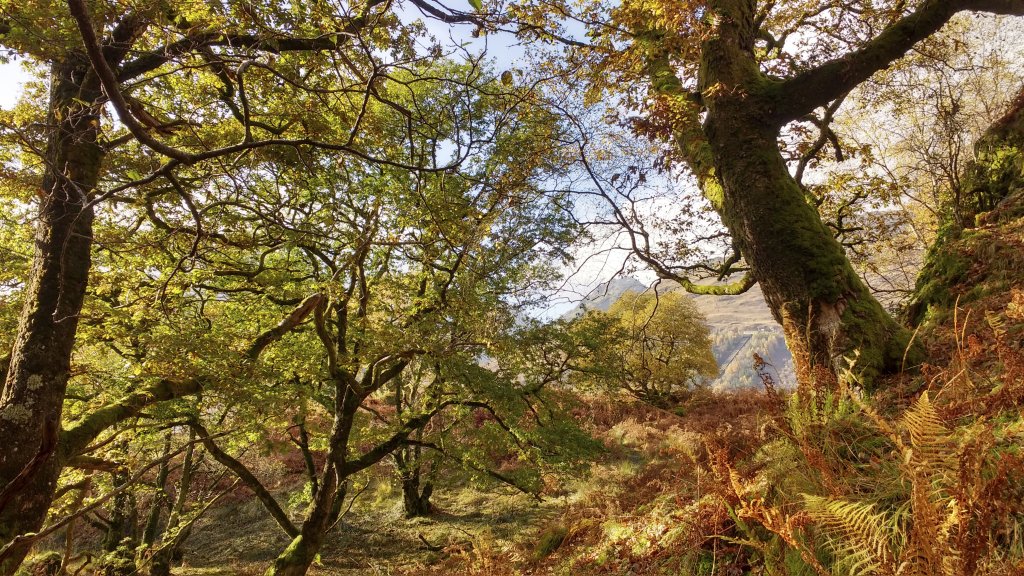Top five historical uses for the rainforest
These days, we know how important Scotland’s rainforest is for its biodiversity and for its positive contribution towards fighting climate change. It’s also hugely valuable for the people who live near and visit these woodlands.
But in the past, the rainforest was a rich resource for remote communities who used the bounties of the natural world around them to survive. Some potential ‘harvests’ from the rainforest are pretty obvious (such as wood for fires and construction, and nuts and berries for food) but for people who knew these sites well, the woodland also held a few surprises.
The lichens that were big business for cloth dyeing
You might be lucky enough to find a lichen in Scotland’s rainforest called a cudbear (Ochrolechia tartarea). It’s a grey lichen, which helps it to stick out from the dark tree trunks it grows on, and its pink fruiting bodies make it even more eye-catching.
This lichen is an indicator species for ancient woodland, and is one of several (which all share the name cudbear) that were used to produce dye.
Women in the Highlands once collected the lichens for dyeing clothes. But in the 18th Century, a coppersmith called George Gordon and his nephew Dr Cuthbert Gordon, who was a chemist, experimented with using the lichens to produce dye on an industrial scale. They eventually patented their dye, and called it ‘Cudbear’.
The dye produced by the cudbear lichens was a reddy purple when processed, a hugely desirable colour for cloth at the time. In fact, dyes were surprisingly big business in Scotland during the 18th century, and at the height of their operations, they were harvesting an extraordinary 250 TONNES of lichens each year!
But producing the Cudbear also proved to be very expensive. Dr Gordon established a business to manufacture the new dye, but he struggled for a long time to make it a success, and even went bankrupt. The good news is that synthetic dyes were discovered in the 19th Century, bringing the need for industrial harvesting of lichens to an end.
Plants for good health and the doctrine of signatures
Back before we had modern medicine, people had to rely on folklore and their knowledge of plants to cure ailments. So-called ‘herbal’ remedies might be looked down on today, but many plants do have medicinal qualities, and some modern medicines still include ingredients that are derived from nature.
However, our ancestors also had some rather odd ideas when it came to medicine. One ancient belief that many followed was the ‘doctrine of signatures’: in basic terms if a plant looks like a thing, it can heal that thing.
One of the indicator species for Scotland’s rainforest is tree lungwort. This large lichen was named for the lungs that it resembles, and true to the doctrine of signatures, it was indeed once used as a remedy for lung conditions. It doesn’t actually do anything beneficial for lungs, but that didn’t stop people trying!
Two other rainforest plants that once served as remedies are the maidenhair spleenwort (used to treat spleen disorders – again, doesn’t seem to work) and the maidenhair fern. Of this, English herbalist John Gerard wrote: “It maketh the haire of the head or beard to grow that is fallen or pulled off.”
A magical cure for baldness? Sadly, there doesn’t seem to be any evidence for that either. But it’s still a beautiful fern!
Winter grazing for livestock
One of the biggest threats to Scotland’s rainforest today is overgrazing. Unnaturally high numbers of red and roe deer, and in places feral animals like goats and sheep, are causing a huge problem.
While woodlands do need some grazing animals, too many reduces the number of saplings, damaging the long-term future of the wood. It can also change the type of plants growing on the forest floor.
If only a small number of animals are kept in the wood, however, it can be beneficial, and indeed, low-impact grazing is still a management system for our rainforests that’s recommended today.
In the past, many communities would have over-wintered their livestock in woodlands so that they had a source of food and some shelter from the worst of the winter weather. Many of the hazel woods and oak woods of Scotland’s rainforest might have been used for this purpose.
Turning trees into charcoal
We often think of the industrial revolution as focused on coal. However, timber production was vital for many industrial processes, and oak was often the tree of choice.
Oaks are one of the commonest trees in Scotland’s rainforest today, and this is partly because these trees were ‘farmed’ back in the 19th century. They were growing naturally in woodlands anyway, but other species were often weeded out to give them plenty of space and allow young oaks to grow.
Most often the oaks were used for the production of charcoal. This is made by piling the wood in a heap and then burning it in a very controlled manner without much oxygen. The resulting material has far wider uses than your barbecue!
Charcoal burns hotter than wood making it ideal for blacksmiths and for processes like smelting iron. It’s also light, making it easy to transport, and doesn’t produce much smoke, meaning it can be used indoors.
Today charcoal burning is still taking place in Scotland’s rainforest, but not with oak. Instead, invasive Rhododendron ponticum is being burnt to produce biochar, a product that locks up carbon, and can be used in agriculture, for absorbing moisture, or even for potting houseplants.
Using the tannin in oak bark to ‘tan’ leather
Oaks were usually coppiced to produce charcoal, like this example at Taynish (pic by Lorne Gill). But they were often grown this way for use in the leather industry as well.
Oak bark contains a lot of tannins, which help to protect the tree from attacks by insects. These tannins can also be used to preserve animal skins in a process called tanning.
Traditionally, tanning was done by soaking the skins in water with a lot of oak bark added, and it would take several weeks for them to be preserved. This allowed them to be transformed into everything from saddles and reins for horses, to straps for machinery, as well as clothing and bags.
The legacy of rainforest industries
While the thought of farmed and coppiced woodlands might spoil our image of Scotland’s rainforest as being truly wild, without industries like charcoal burning, it’s possible that many of our oak woodlands would have been cut down and lost.
However, many of these industries were particularly bad news for lichens. Both charcoal burning and tanning came to an end in these areas around 150 years ago, and some lichens are only just starting to recolonise the young trees that have grown since. It shows how long damage to the rainforest can take to repair.






